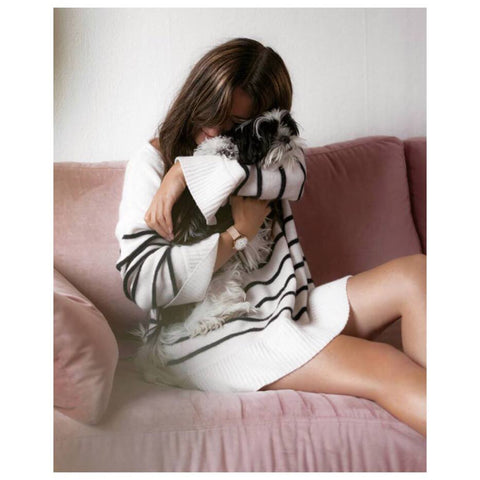
Everything about merino wool
MERINO - YOU'RE MY WONDERWOOL
In case you missed it: we are a fan of merino! A type of wool with beautiful, practical and smart properties that perfectly match the current zeitgeist. And these properties are something we are happy to tell you more about - just take a look at this list.
- Merino is stronger and more resilient than "regular" wool.
- You can simply wash Merino in the washing machine (as long as you are careful and make sure to stick to some important rules).
- Merino keeps you cool in the summer and warm in the winter.
- Merino doesn't itch.
- Merino is anti-bacterial.
- Merino is anti-static and dirt-resistant.
- Merino is biodegradable, so it's kind to the environment.
Did we mention that merino is also timelessly beautiful? In a nutshell: Merino's properties are mainly benefits. Merino: you're my wonder wool!
ABOUT MERINO - WHAT IS MERINO?
Merino is the wool of the merino sheep. Berber tribes in Morocco exported the breed to Spain and there the animals were crossbred with other breeds to further perfect the wool. Merino was so popular in the Middle Ages that high-ranking guests often received a merino sheep as a token of appreciation. An (b)êêêxclusive gift. Sheep farming has now largely moved to Australia and New Zealand. The harvested wool is processed all over the world into yarn that is used to make household textiles - such as blankets - and clothing - as well as sweaters, vests, socks, underwear and even sports and outdoor gear. Merino is a true multitasker. Fun fact: the merino sheep is a stubborn creature with a strong will of its own. Sheep Shrek (No, not the movie, but a real sheep) avoided a shave for 6 - six! -years and developed the looks of a beige Angry Bird without a beak, or a new type of Furby.
ABOUT MERINO - STRONG AS A (HORSE) SHEEP
Merino is strong. It is thinner and lighter than most types of sheep hair - which is what wool really is - and has a natural frizz. This means that a merino knit or fabric has built-in elasticity, even without added lycra. Merino therefore wears less quickly than other wool types - for example on your elbows, even if you prefer not to do heavy lifting work. As a result, it also wrinkles less and it has great shape recovery: merino actually always has a natural perfect beach body by nature. And that without sit-ups.
ABOUT MERINO - WASH (WHAT'S) UP?
You can simply wash Merino in the washing machine. Wtf? Really? Yes really! But you do need to stick to some important rules: use the wool wash program at max 30˚ celsius, and use a special wool detergent (this restores the natural oily lanolin layer - which keeps merino wool supple - intact). Don’t put your sweater in the dryer, and spin any item at max 600 rpm in an empty drum, to avoid too much friction.
That's all for washing, folks. Or no, one more thing: do not let the woolen clothing dry on a hanger, but let it dry on a flat surface instead, unless you like flapping empty bra cups on your shoulders.
But now the real banger: Merino stays clean - thanks to its antibacterial and dirt-repellent properties - just fine without a wash too! Hanging you garment out in the humid outdoor air for a night solves most odor problems. Even if you've baked garlic gambas while wearing your merino sweater, you can then just hop on the bus without everyone in front of you getting up and subtly walking away. Which in itself might be again a disadvantage. Anyway, you get it.
ABOUT MERINO - DAMN HOT & SUPER COOL
Merino keeps you cool in the summer and warm in the winter. Huh? Is that possible? Absolutely! If you know that merino sheep thrive best in the mountains, where the temperature differences vary enormously, then it can only be that our genius Mother Nature has played a part in creating this magic trick too. The merino hair may be ultra-thin and light, but it is also frizzy. Lots of hair clumped together - in the sheep's coat or in your favorite garment - creates a lot of empty space, which has an insulating effect. It retains coolness in summer and warmth in winter. The moisture-regulating properties ensure that any perspiration is quickly and odorlessly removed. So even in the summer months you can choose a nice merino item, even if the summer that year is unexpectedly hot and you don't have time to change in between your romantic seaside dates.
ABOUT MERINO - WHERE THERE IS FLUFF…
Merino can pill and fluff, we're honest about that - but it pills a lot less than other wool types. Why? This is again due to the extra fine hair / fiber, which also ensures that merino is softer, stronger and more resilient than most wool types. And if fluff and pills appear on your favorite merino item, it can be fixed quickly and easily. Where there is fluff, there is a way, and that way is called the fluff clippers. Or for old and fearless fossils under us with a steady hand: a disposable razor and reading glasses :-)
ABOUT MERINO - BIODEGRADABLE
Did you know that merino is biodegradable? No? Well surprise surprise: merino is for 100% biodegradable. In a world where plastic soup is more often on the menu than chicken soup, that is a huge pro. So if your favorite merino item has been ruined and there is no hope to restore it - purely hypothetically speaking, because we don't understand how you could do that - you can bury it in the garden with a clear conscience: it will be completely absorbed by the earth in about 6 months. Dust to dust. Don't believe us? Watch this video:
ABOUT MERINO - EXPENSIVELY SUSTAINABLE
Merino wool is expensive. But expensive is a flexible concept. If you know the reason why merino wool has a higher price tag than other wool types, you will probably understand better.
First of all, merino wool grows very slowly, and can only be 'harvested' twice a year. While the costs of shelter, care and food for the merino sheep continue for 12 months a year. Merino also has a finer structure than most wool types - which is an advantage because merino is softer and less itchy - but… more fibers are needed per garment. Kaaatching $ £ €.
Of course, there are more affordable merino wool items on the market, harvested from merino sheep that are bred and kept under poor conditions. First of all, that is ethically not okay, but it also has consequences for the aesthetic quality. The most beautiful merino comes from sheep that hop freely and happily in the mountains, and are cared for with love and attention. And that is priceless.
You can also judge whether merino is expensive on the basis of its lifespan. A lovingly cared for merino garment will last for years - on average 5 times as long as clothing made from other wools. The more you wear it, the lower the "Cost per wear"
Pst: of course we can't look into your wallet, but reality teaches us that a 100% merino item doesn't fit everyone's budget. A blend with, for example, cotton or viscose also looks very nice, and offers the same feeling of luxury with a slightly more friendly price tag. Less money to spend? Go for a bleêênd ;-).
